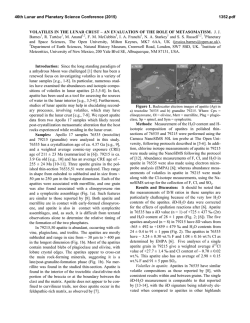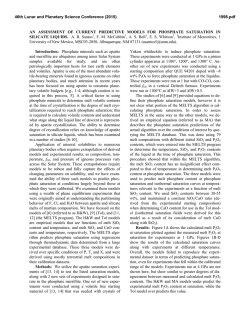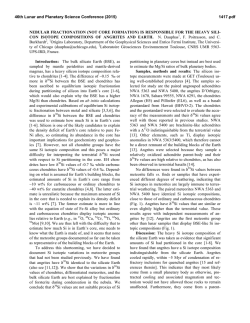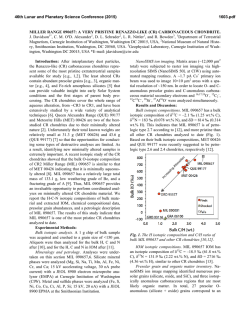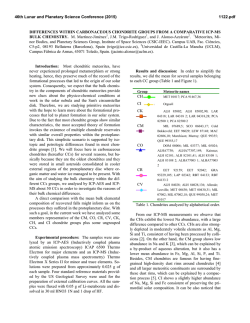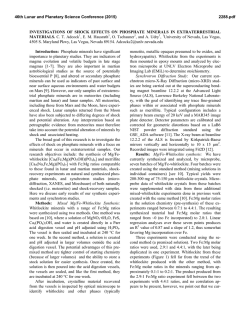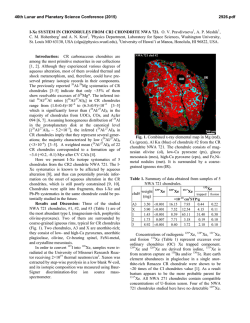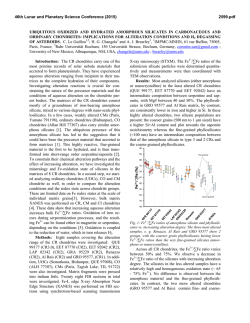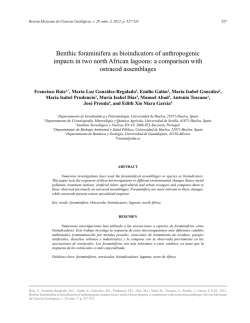
OH, F−BEARING APATITE, MERRILLITE, AND HALOGEN−POOR
46th Lunar and Planetary Science Conference (2015) 2927.pdf OH, F−BEARING APATITE, MERRILLITE, AND HALOGEN−POOR FLUIDS IN ALLENDE (CV3). K. A. Dyl1, J. W. Boyce2, Y. Guan3, P. A. Bland1, J. M. Eiler3, and S. M. Reddy1. 1Department of Applied Geology, Curtin University, GPO Box U1987, Perth, WA 6845 Australia. Email: katie.dyl@ gmail.com. 2Department of Earth & Space Sciences, UCLA, 90095 USA. 3Division of Geological & Planetary Sciences, Caltech, 1200 E. California Blvd., Pasadena, CA 91125 USA. Introduction: Complex water-rock interactions are preserved in carbonaceous chondrites (CCs), the most primitive remnants of the early Solar System (e.g.[1]). Unravelling the hydrothermal history of these planetesimals, however, is impeded by the lack of knowledge regarding the fluid phase that was present. If apatite (Ca5(PO4)3(OH,F,Cl)) is formed during metamorphism, this mineral can be used to constrain the relative activities of HF, HCl, and H2O of the fluid. Previous work has described sulfide-phosphate assemblages in Allende, but only merrillite (Ca18Na2Mg2 (PO4)14), a phosphate devoid of volatiles in its structure, has been identified [2]. Using a combination of NanoSIMS analyses and electron backscatter diffraction (EBSD), we have identified OH-rich apatite in Allende sulfide assemblages that are associated with chondrules. Using previous experimental and theoretical work, we conclude that the apatite compositions require a basic, halogen-poor fluid present on the Allende parent body in order to explain their unusual composition. Methods: Sulfide-phosphate assemblages were identified for study and characterized using a Zeiss 1555 FESEM at the Centre for Microscopy, Characterization, and Microanalysis, University of Western Australia. Volatile content measurements of the phosphate minerals were performed at the NanoSIMS 50-L at Caltech. A Cs+ primary beam (FC0 = 5−10 nA) imaged areas ~8 μm x ~8 μm for the following anions: 16OH‒,18O‒,19F‒, 31P‒, and 35Cl‒. Due to grain size and nearby void space, ion images were obtained and later processed to quantify volatile abundances; in many cases, a correction was required due to 16OH‒ contamination. Electron backscatter diffraction (EBSD) and X-ray maps were obtained using the TESCAN Mira3 FESEM at Curtin University in order to verify the crystallographic structure of the phosphate phases. A step size of 200 nm was used, and phase indexing required a 7 band detection with MAD < 0.5. Results: We analyzed phosphate grains (diameter ~3-5 μm) found in chondrule alteration assemblages. This was done for 3-6 regions in 4 different chondrules, including areas entirely enclosed within a chondrule and those in sulfide-rich rims. Coexisting minerals included pyrrhotite, pentlandite, enstatite, and olivine (~Fa40). Textures were consistent with altered metal or sulfide. NanoSIMS: Volatile Contents of Phosphates. Two distinct phosphate minerals were identified by their volatile contents: 1. phosphates containing no discernible volatiles above background values, presumably merrillite and 2. phosphate with apatite stoichiometry containing 1.2‒1.4 wt% H2O, 6,000‒10,000 ppm F, and 900‒3,000 ppm Cl (X(H2O) ≈ 0.7, X(F) ≈ 0.25, X(Cl) ≈ 0.05, where X is the fractional occupancy of the −1 anion site). These minerals were often found together in the same assemblage. Analyses are displayed in Figure 1 as grey circles. The volatile contents of apatite measured in ordinary chondrites [3], the Martian meteorite Shergotty [4], and the Moon [5] are also shown for comparison. EBSD: Phosphate Crystallography. Selected sulfide-phosphate alteration assemblages were mapped using EBSD to independently verify the presence of apatite. A phase map of one such region is observed in Figure 2, as well as a compositional map of Ca (red), Fe (green), and Si (blue); the white box indicates a region imaged via NanoSIMS. The predominant phosphate is apatite (Fig. 2c), which coexists with pentlandite and olivine. This identification agrees with the NanoSIMS measurements. The red grain (Fig. 2d) is indexed as whitlockite (Ca9(Mg, Fe2+)(PO4)6[PO3(OH)]), Figure 1: A ternary plot of X site occupancy (OH, F, Cl) for extraterrestrial apatites. Regions approximate the range of literature data for ordinary chondrites (OCs, red), the Moon (green), and Mars (blue). Allende analyses reported here, the first for carbonaceous chondrites, are shown as grey circles. 46th Lunar and Planetary Science Conference (2015) a volatile -poor phosphate with nearly identical structure to merrillite. Electron backscatter patterns (EBSPs) of both phases are also provided. Discussion: Previous trace element studies, in particular of U and Th, suggest that apatite exists in CCs that have experienced aqueous alteration [6]; however, prior to this study, only a single apatite crystal had been reported in Orgueil (CI) [7]. While difficult to analyze due to their size (~μms) and nearby void space, the apatite grains characterized in Allende allow for a quantitative description of the reacting fluid(s), in particular its halogen content and acidity. Previous experimental [8] and theoretical [9] work has calculated the relationship between the mole fraction of apatite endmembers to the relative activities of HF, HCl, and H2O in the fluid. At 300ºC and the water vaporization pressure (86 bar), the OH-rich compositions we measured require log (aHFº/aH2O) < 10−7 and log (aHClº/aH2O) < 10−4 [9]: a halogen-poor, basic fluid. Studies of secondary minerals in Allende, such as andradite-hedenbergite nodules within matrix, suggest a Ca-Fe-Na-rich fluid where Si, Mg, Mn, and S are soluble [1]. While acidic fluids can facilitate such mass transport, and Cl can form complexes with many metals, the apatite compositions appear to rule out these mechanisms. They suggest, rather, that OH− or S-bearing species are the predominant anion(s) controlling speciation of the fluid. Also of note is the coexistence of apatite and merrillite in Allende. While both are commonly observed in extraterrestrial rocks, merrillite is usually associated with OH-poor apatite [3,5], implying low a(H2O). Whitlockite and apatite have also been found together in mantle xenoliths that have undergone metasomatism; the authors argue that whitlockite forms from a later, “dry” fluid different from that which formed apatite [10]. However, recent work has shown that merrillite may not be indicative of low water activity. Merrilite and OH-bearing apatite (up to 8600 ppm H2O) are both found in the Martian meteorite Shergotty; it is suggested that the ratio of P to F+Cl, not water, controls the formation of apatite versus merrillite [4]. If the Allende assemblages were originally Fe-metal, they would be enriched in phosphorous due to condensation of FeP3 as a solid solution with Fe-alloy at 1200-1300K in the Solar Nebula [11]. The presence of merrillite, therefore, may not imply low a(H2O) during metamorphism in the Allende parent body. Conclusions: Sulfide-phosphate assemblages in Allende chondrules, thought to be the result of aqueous alteration, contain both merrillite and apatite as confirmed by EBSD mapping. NanoSIMS measurements of their volatile contents reveal that the apatite is OHrich and Cl-poor, in contrast to other extraterrestrial 2927.pdf apatite compositions. The fluid from which the apatite grains formed must be extremely depleted in both F and Cl. Further thermodynamic and speciation models are required to ascertain the water activity that characterizes this metamorphism. References: [1] Krot A. N. et al. (2007) Geochimica et Cosmochimica Acta 71:4342-4364. [2] Rubin A. E. and Grosman J. N. (1985) Meteoritics 20(3):479-489. [3] Jones R. H. et al. (2014) Geochimica et Cosmochimica Acta 132:120-140. [4] McCubbin F. M. et al. (2014) American Mineralogist 99(7):1347-1354. [5] McCubbin F. M. et al. (2011) Geochimica et Cosmochimica Acta 75:5073-5093. [6] Rocholl A. and Jochum K. P. (1993) Earth & Planetary Science Letters 117:265-278. [7] MacKinnon I. D. R. and Kaser S. A. (1990) Meteoritics 25:381. [8] Korzhinskiy M. A. (1981) Geochemistry International 18(3):44-60. [9] Zhu C. and Sverjensky D. A. (1991) Geochimica et Cosmochimica Acta 55:1837-1858. [10] Ionov D. A. et al. (2006) Earth & Planetary Science Letters 244:201-217. [11] Lodders K. (2003) The Astrophysical Journal 591:1220-1247. Figure 2: a. EBSD band contrast map + X-ray maps: Ca (red), Fe (green), and Si (blue). The white box indicates a NanoSIMS analysis region. b. Band contrast + phase map containing the following minerals: whitlockite (red), enstatite (yellow), olivine (green), apatite (blue), pentlandite (purple). Black areas indicate regions where pattern quality was too poor to index. Arrows pointing to (c) and (d) correspond to the EBSPs where (c) is apatite (9 bands indexed) and (d) is whitlockite (8 bands indexed). The black, dashed lines indicate the bands detected via the Oxford Instruments AzTEC software.
© Copyright 2026
